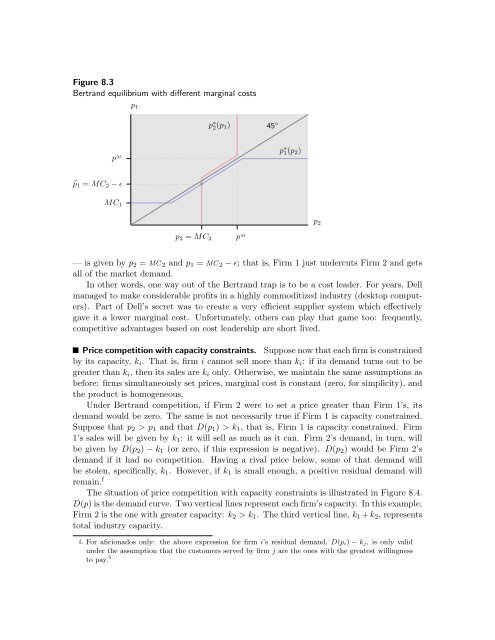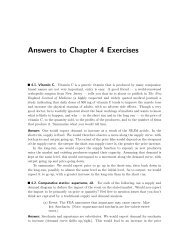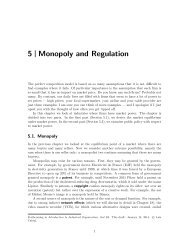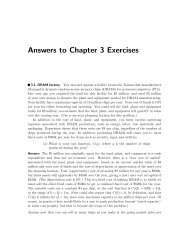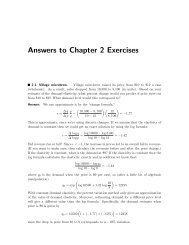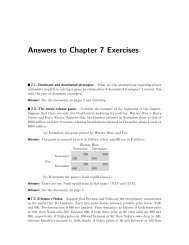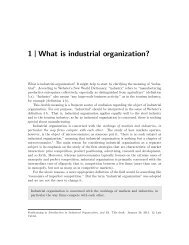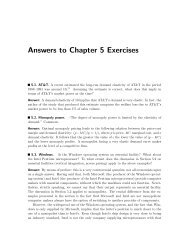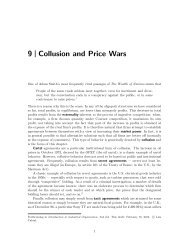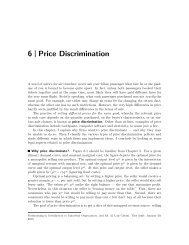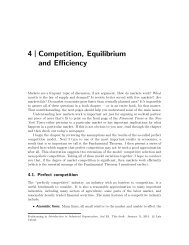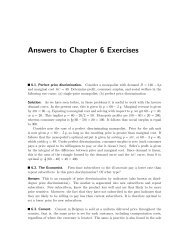8 Oligopoly - Luiscabral.net
8 Oligopoly - Luiscabral.net
8 Oligopoly - Luiscabral.net
Create successful ePaper yourself
Turn your PDF publications into a flip-book with our unique Google optimized e-Paper software.
Figure 8.3<br />
Bertrand equilibrium with different marginal costs<br />
p ∗ 2(p 1 )<br />
45 ◦ p ∗ 1(p 2 )<br />
p M p 2 = MC 2 p M<br />
p 1 ... .... .... .... .... .... .... .... .... .... .... .... .... .... .... .... ... .... .... .... .... .... .... .... .... .... .... .... .... .... .... .... .... . ....................<br />
p 2<br />
̂p 1 = MC 2 − ɛ<br />
•<br />
... ..... .... .... .... .... .... .. . .... ... .... .... .... .... ..... .... ... .... .... .... .... .... .<br />
............<br />
MC 1<br />
— is given by p 2 = MC 2 and p 1 = MC 2 − ɛ; that is, Firm 1 just undercuts Firm 2 and gets<br />
all of the market demand.<br />
In other words, one way out of the Bertrand trap is to be a cost leader. For years, Dell<br />
managed to make considerable profits in a highly commoditized industry (desktop computers).<br />
Part of Dell’s secret was to create a very efficient supplier system which effectively<br />
gave it a lower marginal cost. Unfortunately, others can play that game too: frequently,<br />
competitive advantages based on cost leadership are short lived.<br />
Price competition with capacity constraints. Suppose now that each firm is constrained<br />
by its capacity, k i . That is, firm i cannot sell more than k i : if its demand turns out to be<br />
greater than k i , then its sales are k i only. Otherwise, we maintain the same assumptions as<br />
before: firms simultaneously set prices, marginal cost is constant (zero, for simplicity), and<br />
the product is homogeneous.<br />
Under Bertrand competition, if Firm 2 were to set a price greater than Firm 1’s, its<br />
demand would be zero. The same is not necessarily true if Firm 1 is capacity constrained.<br />
Suppose that p 2 > p 1 and that D(p 1 ) > k 1 , that is, Firm 1 is capacity constrained. Firm<br />
1’s sales will be given by k 1 : it will sell as much as it can. Firm 2’s demand, in turn, will<br />
be given by D(p 2 ) − k 1 (or zero, if this expression is negative). D(p 2 ) would be Firm 2’s<br />
demand if it had no competition. Having a rival price below, some of that demand will<br />
be stolen, specifically, k 1 . However, if k 1 is small enough, a positive residual demand will<br />
remain. f<br />
The situation of price competition with capacity constraints is illustrated in Figure 8.4.<br />
D(p) is the demand curve. Two vertical lines represent each firm’s capacity. In this example,<br />
Firm 2 is the one with greater capacity: k 2 > k 1 . The third vertical line, k 1 + k 2 , represents<br />
total industry capacity.<br />
f. For aficionados only: the above expression for firm i’s residual demand, D(p i) − k j, is only valid<br />
under the assumption that the customers served by firm j are the ones with the greatest willingness<br />
to pay. 5


